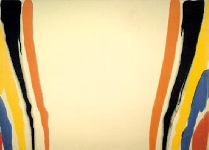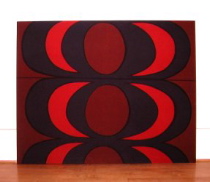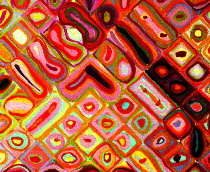
I never painted an abstract picture until I got to Tyler. That was after taking classes for a couple years at PAFA. In response to an assignment to paint a self portrait (don’t laugh) and spurred on by some macho impulse to do it my way, I let loose with the big brushes and big gestures and turned in something abstract — and laughable. The teacher, to his credit, told me to get real.

He meant two things, first, that my abstract painting was out of character for someone he knew as a cartoonist. And secondly, that self-portraiture, at base, is not abstract.
So what exactly is the impulse to make abstract painting anyway? I’ve been thinking about that alot lately as I saw the NY Abstract show at Klein Gallery and read Raphael Rubinstein’s recent Art in America reviews of eight contemporary painters (most of them abstract).
Libby and I have both been in a stew about painting and we’ve been talking about it incessantly. (For some of Libby’s thoughts, see her great post of Nov. 28). I agree with her that the best art delivers thoughts about human concerns.
So where does that leave abstract art? Are there human concerns in a stripe painting? Do drip and stain and color field paintings really make you think of the human condition? (I know I’m being very general, but I saw a big Morris Lous stain painting yesterday at the PMA and for the life of me it was just like Marimekko…) (image top is Louis’s “Alpha” 1960; image right below is Marimekko cloth design)

The metaphor for paintings is usually the mirror or window. But in my experience, abstract paintings are veils. Can you make an abstract painting a mirror? Maybe a painter like Neyssa Grassi, whose work evokes both the body and the mind, with her knotty, intestinal imagery, is making abstract mirrors. Grassi’s show of new gouache paintings opens Friday at Locks Gallery. (image above is Grassi’s “Both Worlds,” 2002)
How about Chuck Close? He’s a photo-realist who uses abstractionist means. (see image, left, and detail, right, below, of Close’s “Paul”)
For me painting abstract — which I come back to from time to time just to try again — is like trying on a beautiful, exotic sweater to see how it feels, see how the cut of it works on me. While I’ve made a lot of pretty abstract paintings, they never feel like “me” though. They tell me a little about my dialog with myself but to someone outside my head they’re just pretty pictures.
Here’s my question, and I’d love some help with this. Is abstract painting different from other art in that it’s veil-like instead of mirror-like? Is it a separate branch on the art family tree? Is it, in fact, a dead end…the Neanderthal of art?
I’ve always thought the huge color field paintings that take up so much museum wall space would not stand the test of time. I still think that, so I guess I’m biased to begin with. But now I wonder if Jackson Pollock’s work, or Mark Rothko’s, for example, will also undergo revision downward in the canon and become interesting footnotes in art history texts instead of something considered seminal.
Not that I want to bomb art back to the stone age, but what is driving the never-ending story of abstract painting. Thoughts anyone?









